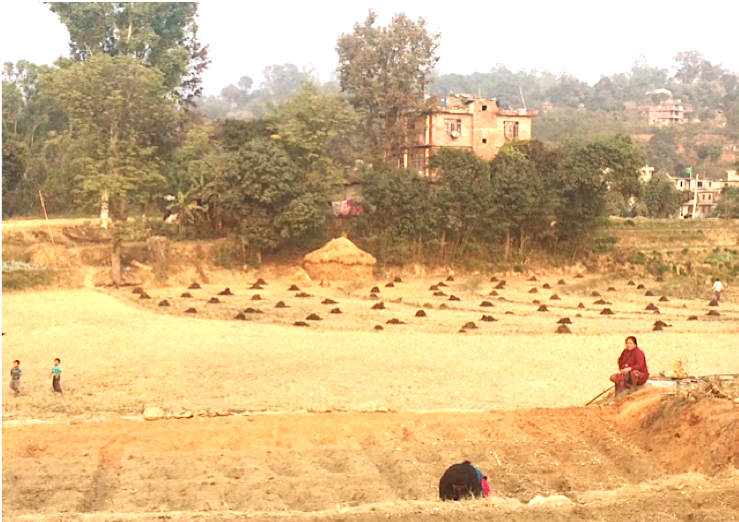
Amarante Consulting was recently contracted by UNCDF in Nepal to develop remittance-linked use-cases for migrants on an innovative digital architecture. We kick-started this project in October 2018 with the preparation of a concept note, identification of partner institutions and a market scan. As a next step, we travelled to the rural and semi-urban areas of Banepa and Panchkal to interview a range of stakeholders including migrants and their families, banks, cooperatives, micro-credit development organisations and remittance agents. The insights from the field have been compelling, spurring a relook at common assumptions.
Nepal has witnessed widespread domestic and international migration for decades. In 2016-17, 382,871 labour permits were issued to international migrants. This figure is an underestimate as a number of Nepalis, notably women take the unofficial route to migrate. In addition, migration to India is not officially accounted for because of the open border policy between the governments of India and Nepal. Remittance inflows to Nepal have grown tremendously, yet steadily, over the past decade or so, increasing from USD 111 million in 2000 to USD 6.9 billion in 2017. In fact, in 2017, Nepal’s remittance inflows accounted for 28.39% of its gross domestic product, making Nepal one of the largest remittance-receiving countries in terms of percentage of GDP. This growth engendered a magnified Digital Financial Services(DFS) sector, with the Central Bank(The Nepal Rastra Bank) stepping in with policies to aid the remittance sector and promote the expansion of branchless banking.
While Nepal has witnessed the growth of a robust digital ecosystem with 50 remittance companies being licensed into operation and a fair number of financial service providers widening their DFS network to streamline the receipt of remittance inflows, multiple research studies have indicated that remittance inflows have not necessarily aided in socio-economic development, contrary to common expectations. Remittances are normally channelled into household consumption and/or repayment of loans among remittance-receiving households, with little being earmarked for future savings or productive investments, thereby constraining asset-building and capital formation. UNCDF, with Amarante’s technical assistance, conceptualised a greenfield intervention in addressing this hitherto trend through the development of customer-centric, remittance-linked financial products to enable productive usage of remittance inflows. On the supply-side, this intervention would help banks and financial institutions build a stable deposit base that could boost investment and credit in the local economy.
The design of remittance-linked financial products however, calls for an understanding of the financial behaviour and preferences of migrants and their families. As we set out on extensive fieldwork in and around Kathmandu, we discovered some rich insights. Our findings more or less converge with the conclusions of most academic studies that have examined the linkages between remittances, agrarian development and poverty alleviation in the context of Nepal– migration and remittances in Nepal seem to be deeply gendered.

Majority of Nepal’s international migrants are men who migrate to wealthier countries in search of better economic opportunities. Research indicates that 62.5% of these migrants are married – they migrate leaving their wives and children behind (Department of Foreign Employment Status Report, 2016-17). Most women migrants we spoke to were hesitant to open savings accounts or take out credit to fund income-generating activities in the absence of the male migrant. Banks and cooperatives attested to this trend, confirming that financial products tend to be used more by men relative to women. Upon digging deeper, we uncovered some complex social and economic factors at play. First, financial decision-making is the prerogative of the male migrant remitter. Second, women because of their social status tend to be less literate and less able to run businesses or manage farms left behind by their male counterparts. As a result, remittances do not necessarily translate to capital formation or asset/income generation in the home country, contributing instead to household consumption.

In order to build customer-centric remittance-linked financial products, it is imperative that a thorough gender analysis inform product design and delivery. It is essential that our products and processes do not entirely disrupt existing social norms but at the same time encourage a participatory approach. For example, if decisions in the household are made by the male remitter, then a potential credit product could allow for the participation of both remitter and beneficiary. Also, the beneficiary could partake as a borrower and the remitter as a guarantor or vice versa. These approaches enable joint accountability to the use and repayment of the credit product. At the same time, savings products that cater to the needs of both the migrant remitter and the beneficiary – such as a retirement type savings account for the male migrant remitter (since most host countries do not offer social security benefits) and a recurring deposit/goal-based savings for the woman beneficiary in Nepal – could be explored. The idea is to pay close attention to seemingly important distinctions between remittance stakeholders and create a product structure that reflects these nuanced differences.
As we go along, our goal is to look out for trends, patterns and socio-economic factors that influence how migrants perceive and use remittances. This is an evolving exercise and we will need to continuously rely on evidence to build the right kind of financial products and services to drive their uptake, usage and adoption among migrants and their families.
For more on the same, read our blog posting for UNCDF: Linking Remittances with Digital Financial Services